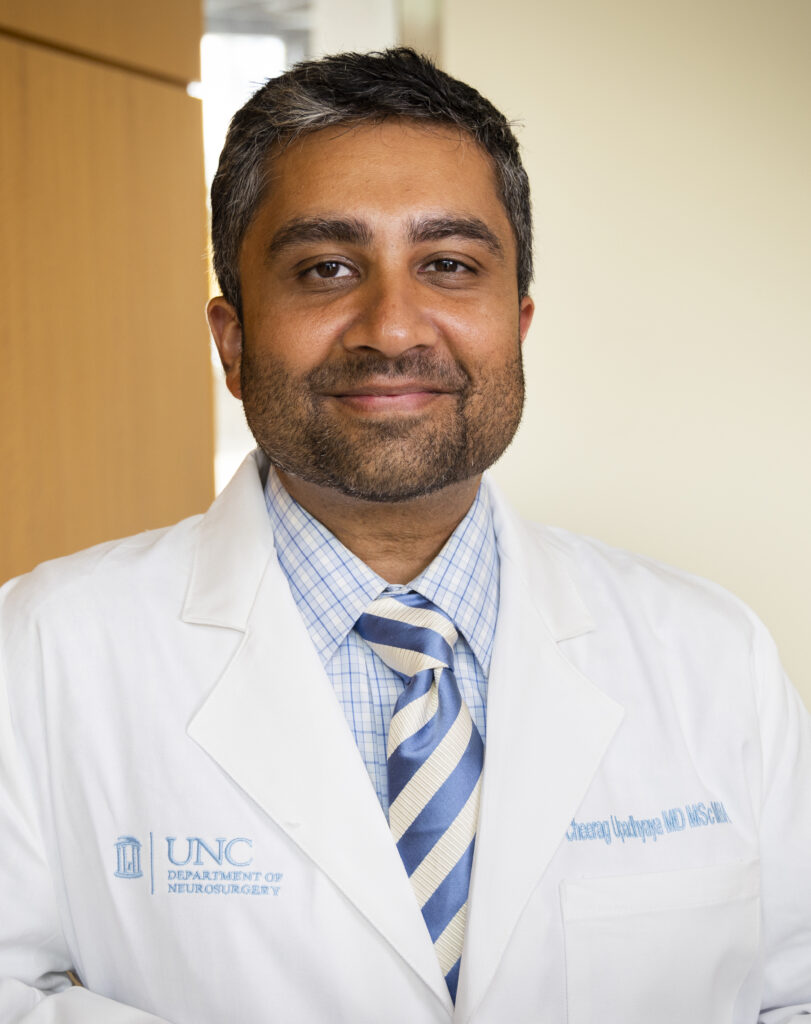

Cheerag Upadhyaya, MD, MBA, MSc, FAANS, FACS
Vice Chair Outpatient Operations
Chief Transformation & Business Development Officer
Clinical Associate Professor
The minimally invasive spine surgery and motion preservation program at UNC Health is led by spinal neurosurgeon, Dr. Cheerag Upadhyaya. For many patients with back or neck pain, spinal fusion surgery is not the only surgical option. During your consultation visit, Dr. Upadhyaya will discuss your health history and conduct a physical exam to determine if you are a candidate for surgery.
We offer the following minimally invasive spine surgery procedures:
Minimally invasive transforaminal lumbar interbody fusion (TLIF)
Minimally invasive foraminotomy
Minimally invasive laminectomy
Minimally invasive posterior cervical foraminotomy
Minimally invasive lateral surgery
Minimally invasive deformity surgery
Minimally invasive discectomy
Minimally invasive tumor resection
We offer the following motion-sparing spinal surgery procedures:
Cervical arthroplasty
Cervical laminoplasty
Dr. Upadhyaya performs minimally invasive spinal surgeries at UNC Health. Minimally invasive techniques are used to perform operations including diskectomy, laminectomy, foraminotomy, spinal fusion, and even spinal deformity. These procedures are typically performed when more conservative treatment methods, such as medication or physical therapy, fail to provide pain relief, or if there is significant spinal cord or nerve root compression.
Minimally invasive spinal fusion is often used on patients with severe spinal nerve root compression. During the procedure, a spinal neurosurgeon creates two small incisions in the back to access the spine. The spinal neurosurgeon then fuses together two or more vertebrae of the spine to relieve pressure on the nerves and spinal cord.
A minimally invasive discectomy is a surgical procedure used to remove a herniated or degenerative disc in the lower spine for patients with disc injuries or diseases. A minimally invasive laminectomy is a surgical procedure used to remove bone spurs and excess ligaments that are compressing the spinal nerves.
Motion preservation surgery is surgery on the spine that works to relieve pressure on the spine while preserving a patient’s range of motion. Many patients experience debilitating pain caused by a variety of conditions or injuries to the spine. Dr. Upadhyaya looks to motion preservation surgical options to determine if it is possible to relieve symptoms while preserving range of motion.
Patients that may qualify for this type of surgical procedure includes patients with:
Spinal stenosis
Degenerative disc disease
Cervical radiculopathy
Lumbar radiculopathy
Myelopathy
Neurogenic claudication
Spondylolisthesis

Cervical laminoplasty is a surgical procedure used to relieve pressure on the spine. Instead of having to remove the bone, our surgical team reshapes the bone and uses hardware to keep it in place. This procedure can help patients retain proper range of motion in the spine.
The benefits of minimally invasive spine surgery include smaller incisions, shorter recovery, reduced risk of surgical complications, less blood loss during surgery, reduced risk of infection, and reduced postoperative pain. Scarring after surgery is also significantly smaller since the incision site is smaller.
Some minimally invasive spine procedures can be performed in an outpatient clinic, and these patients are able to go home same-day. Patients typically stay for a couple of hours after surgery for close evaluation before going home, and will require a caretaker to drive them home and stay with them during recovery. Physical therapy may be recommended after surgery to aid in a patient’s recovery.
Dr. Upadhyaya will go over specific post-op instructions, including medications and activity restrictions, before surgery. Recovery time will depend on the type of surgery.
Spinal fusion is a surgical procedure that is performed to connect bones in the spine separated by spinal abnormalities or injuries to alleviate pain and restore function. Most patients with back pain will not require surgery for treatment. Spinal fusion surgery is recommended to patients who have tried other, non-surgical treatments to alleviate their pain. Spinal fusion may also be recommended to patients with abnormal curves in the spine caused by scoliosis, as well as patients with spinal fractures, spine weakness caused by infection or spine tumors, degenerative disc disease, or severe chronic back pain.
Dr. Cheerag Upadhyaya is the Director of the Minimally Invasive Spine Surgery and Motion Preservation Program at UNC Health. Dr. Upadhyaya is a board-certified neurosurgeon specializing in minimally invasive spine surgery and complex spine surgery. He also serves on the editorial board of the Journal of Neurosurgery and Spine and is an active member of the Scoliosis Research Society, American Association of Neurological Surgeons, Congress of Neurological Surgeons, and Section on Disorders of Spine and Peripheral Nerves. Dr. Cheerag Upadhyaya recently made the Castle Connolly’s Top Doctor List for the third year in a row.


Vice Chair Outpatient Operations
Chief Transformation & Business Development Officer
Clinical Associate Professor